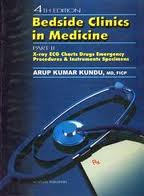Bedside Clinics In Medicine Kundu Pdf Reader
Results The median age of the 731 patients who underwent randomization was 61.4 years; 49 percent had received two prior chemotherapy regimens, and 93 percent had received platinum-based chemotherapy. The response rate was 8.9 percent in the erlotinib group and less than 1 percent in the placebo group (P. Lung cancer is the leading cause of cancer death among men and women in North America.

In advanced non–small-cell lung cancer, chemotherapy offers symptomatic relief and modest improvement in survival; responses are brief, with a median time to progression of three to five months. Disfear Torrent Discography Beatles. Second-line chemotherapy with docetaxel can prolong survival after platinum-based therapy for non–small-cell lung cancer. However, there is at present no defined role for third-line chemotherapy.
Title, Bedside Clinics In Medicine Part Ii, 4/e. Author, Arup Kumar Kundu. Publisher, Variety Book Depot. Export Citation, BiBTeX EndNote RefMan. To ask other readers questions about Bedside clinics in Medicine Part - 1, please sign up. Be the first to ask a question about Bedside clinics in Medicine Part - 1. Sketchup 5 Free Download Crack For Gta. ইচ্ছে ডানা -Icche Dana Dr Jeeno Jayan's Simple Orthopaedics PDF Dr.Vivek Medicine Discussion Troll MMC - Official Techfest, IIT Bombay Medical Note App Medicinae Imagini Smile Studio Multispeciality Dental Clinic & Root Canal Centre Pathology mini tutorials. Nov 30, 2014. Srb's Bedside Clinics in Surgery, This simple and reader-friendly book provides essential information to gain clinical understanding of surgery Unique of its kind with illustrations, clinical methods, X-rays, discussion on surgical pathology and basic surgical procedures A more of clinical and practical book.
The futility of offering third-line chemotherapy was demonstrated by Massarelli et al., who reported a response rate of only 2 percent and a median survival of four months. Shepherd et al. Showed that among patients treated with docetaxel after the failure of two or more chemotherapy regimens, survival was identical to that among patients treated with supportive care. The epidermal growth factor receptor (EGFR) family is part of a complex signal-transduction network that is central to several critical cellular processes. Since EGFR is often found in non–small-cell lung cancer cells, it has been the focus of efforts to develop new agents that target the EGFR pathway.
Erlotinib (Tarceva, OSI Pharmaceuticals) and gefitinib (Iressa, AstraZeneca) inhibit the tyrosine kinase activity of EGFR and have been studied extensively. In randomized phase 2 trials of gefitinib (Iressa Dose Evaluation in Advanced Lung Cancer [IDEAL] 1 and 2), the tumors of 10 to 20 percent of patients who were previously treated with platinum-based regimens responded, and in a phase 2 trial of erlotinib among previously treated patients with non–small-cell lung cancer in which 10 percent or more of the cells expressed EGFR, the response rate was 12.3 percent. These promising rates are perhaps higher than those possible with other forms of chemotherapy, but it is unknown whether treatment with an EGFR inhibitor prolongs survival.
For this reason, the National Cancer Institute of Canada Clinical Trials Group (NCIC CTG) conducted a trial (BR.21) to compare erlotinib with placebo after the failure of standard chemotherapy for non–small-cell lung cancer. The inclusion of a control group receiving placebo was considered ethical in view of the lack of benefit from further chemotherapy after the failure of standard treatment. Study Design This international, phase 3, randomized, double-blind, placebo-controlled trial of erlotinib after the failure of first-line or second-line chemotherapy for non–small-cell lung cancer was designed by the NCIC CTG.
Patients were randomly assigned in a 2:1 ratio to receive oral erlotinib at a dose of 150 mg daily or placebo. Randomization was performed centrally by Applied Logic Associates (Houston), with the use of the minimization method. Patients were stratified according to center, Eastern Cooperative Oncology Group performance status (0 or 1 vs. 2 or 3, with higher scores indicating greater impairment), best response to prior therapy (complete or partial response vs. Stable disease vs.
Progressive disease), number of prior regimens received (one vs. Two), and exposure to prior platinum therapy (yes vs. The primary end point was overall survival.
Secondary end points included progression-free survival, overall response rate (complete and partial), duration of response, toxic effects, and quality of life. Responses were assessed with the use of the Response Evaluation Criteria in Solid Tumors (RECIST), and toxic effects were assessed according to the Common Toxicity Criteria of the National Cancer Institute (version 2.0). The European Organization for Research and Treatment of Cancer (EORTC) quality-of-life questionnaire (QLQ-C30) and the quality-of-life questionnaire for patients with lung cancer (QLQ-LC13) were used to evaluate patients' quality of life. The protocol was approved by the ethics review boards at all participating institutions, and all patients provided written informed consent.
Comments are closed.